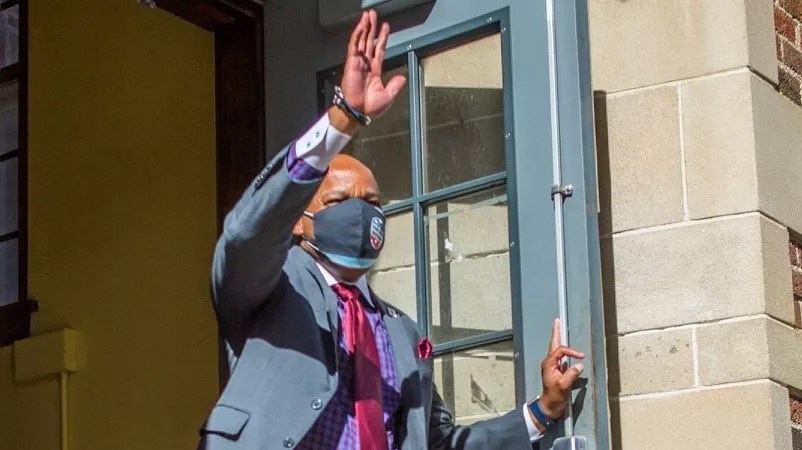

Audio By Carbonatix
At an October 27 press conference, Mayor Michael Hancock confirmed that the City and County of Denver, which had been at Safer at Home Level 2 (Concern) on the Colorado Department of Public Health and Environment‘s dial for COVID-19 restrictions, has been moved to Safer at Home Level 3 (High Risk) because of worsening data across the board, particularly the number of positive cases.
Among the ramped-up restrictions, which go into effect immediately and must be completed by the afternoon of October 28: Restaurants, retail businesses and offices that are currently operating at 50 percent capacity must reduce that to 25 percent, and indoor events must implement a 25-person cap, with a 75-person maximum for events taking place outside.
Variances granted to the Denver Zoo, Botanic Gardens, Cherry Creek Shopping Center, Four Mile Park and the National Western Complex are unaffected by the new public health order for now, and the same goes for gyms – although Denver Department of Public Health and Environment Executive Director Bob McDonald said that changes related to those could be coming soon.
Voting centers will remain open, however, and Hancock encouraged those who can’t vote at home and then take their completed ballot to an election drop box to use those centers over the next week, stressing that they will remain safe.
Early on in his remarks, Hancock put much of the blame for the spiking statistics on visitors to Denver, whether from elsewhere in the metro area or more far-flung locales. “Despite our best efforts and the fact that most Denverites are dutifully wearing face coverings, practicing social distancing, postponing family gatherings and otherwise making sacrifices, Denver is not an island,” he said. “It’s the capital city, the largest city in the state, and we cannot control what our near neighbors and others are doing when they come here. Don’t believe this is Denver’s failing. It’s the failing of those who do not believe in science and those who refuse to take it seriously.”
On October 26, the state released the latest stats that included these for Denver:
Two-week cumulative incidence rate:
347.3 (Safer at Home Level 3: High Risk)Two-week average positivity:
7.0 percent (Safer at Home Level 2: Concern)Number of days with decreasing or stable new hospitalizations:
9 (Protect Our Neighbors: Careful)
While the positivity rate and hospitalization trends alone would have kept Denver in Safer at Home Level 2, the incidence rate was basically double the 175 cases per 100,000 people that were required under that classification, and they jumped even higher later that day, to 384.6. As a result, the CDPHE formally moved Denver to Safer at Home Level 3, mirroring a move the agency recently made regarding Adams County.
To return to Safer at Home Level 2, Denver must maintain a 175-case average over a two-week period – which means that Denver should be at Safer at Home Level 3 for at least that long. But McDonald hinted that if Denver gets close to the mark while improving in other areas, the CDPHE might be flexible regarding when the city can move back to Safer at Home Level 2.
After conceding that “the numbers are the numbers,” Hancock placed Denver’s downgrade in perspective. “This is what we get when we don’t have a national strategy, where we’re piecemealing the approaches. States like Colorado took this seriously, but others took the approach similar to our leadership in Washington, which has pretended there was no pandemic,” he said, adding that if the current administration had taken a more serious tack, “the story might be different today.”
He likened the current scenario to the myth of Sisyphus: “Since March, we’ve all been working hard, pushing the boulder up the hill – slowly making progress, getting back to normal. But that boulder has rolled back on us, because some people have decided they didn’t want to push it anymore.”
McDonald noted that case counts are rising across all demographics, and both the positivity rate and hospitalizations are heading in the wrong direction. Indeed, he revealed that intensive-care-unit capability is diminishing so quickly that a crisis point could be reached in just a couple of weeks. Complicating the situation is the start of flu season, which will further strain the health-care system – but McDonald stressed that the novel coronavirus is a far more serious malady that spreads with tremendous rapidity, in part because asymptomatic individuals who’ve been infected can unconsciously pass it to others, particularly if they’re cavalier about mask usage.
In a question-and-answer session, McDonald confirmed that the order will not immediately require Denver Public Schools to return to an all-virtual format. Hancock, for his part, expressed concern about how restaurants that are barely hanging on at 50 percent capacity will be able to handle the reduced numbers from an economic standpoint. Yet he also delivered some optimism.
“I believe we’ve already proven we can take control of the numbers we’re seeing and reverse them,” he maintained. “So I’m sending a clarion call to everyone that we have a responsibility to once again put our hands on this boulder and push it back up the hill,” rather than see a further deterioration that might necessitate another stay-at-home order.
“We want to avoid that at all cost,” he concluded.